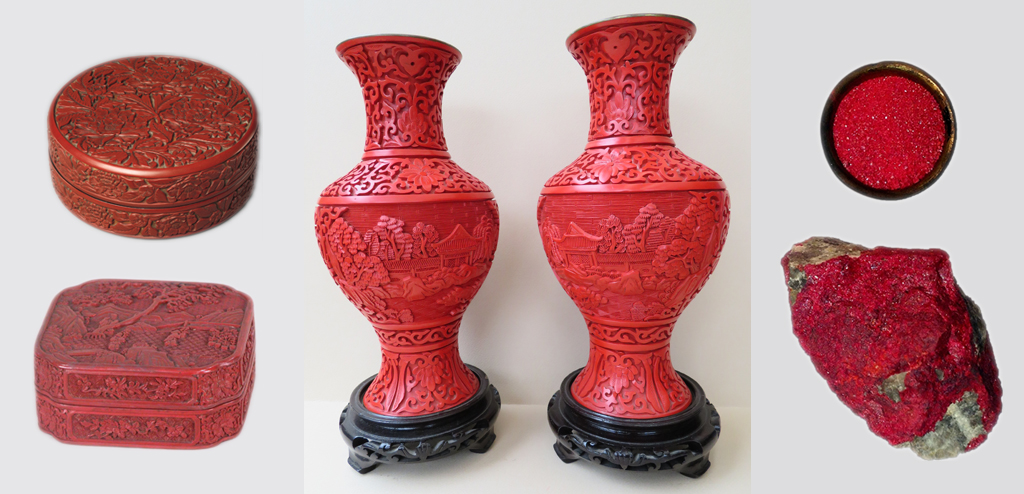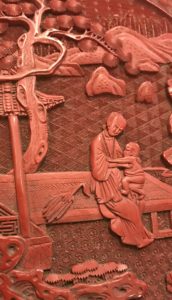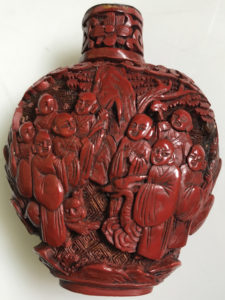
Do You Own Chinese Cinnabar?

Cinnabar derives its name from the ancient Greek word κιννάβαρι, pronounced “kinnabari.” It’s a brick-red or bright red vein-filling mineral that forms in proximity to alkaline hot springs, as well as after recent volcanic activity.
Since cinnabar is a form of mercury sulfide, it has toxic qualities when consumed in large doses. In smaller doses, it was used for religious purposes in ancient civilizations, as well as in pre-colonial Latin America. However, antique cinnabar is most commonly used as a pigment in paint, ceramics, and lacquer.
Uses of Cinnabar in History

One of the oldest known uses of cinnabar was by the Vinca culture, which flourished on the banks of the Balkan from approximately 4800 B.C. to 3500 B.C. Artifacts discovered by archeologists revealed the use of high-quality cinnabar in the paint on figurines and ceramics. Ancient cultures in the Near East, such as the Mesopotamians and Sumerians, applied cinnabar as a cosmetic rouge. The Mesoamerican Olmecs (1200 B.C. to 400 B.C.), known for their highly distinctive, often naturalistic sculptures, used it as a pigment in their ceramics and to decorate their stoneware. The Romans (100 B.C. to 300 A.D.) used cinnabar as a pigment for lavish murals for both private homes and public buildings.
For the Mayans (2000 B.C. – 1697 A.D.), cinnabar was loaded with religious symbolism, as they believed the bright red powder symbolized blood. This is illustrated by the Tomb of the Red Queen in Palenque, which was discovered by an expedition in 1994. After making their way into the burial chamber of one of Palenque’s ruins, the archeologists found a large limestone sarcophagus. Inside lay the remains of a Mayan noblewoman who must have been approximately 60 years old at the time of her death. Her body was adorned with many jade and pearl objects and pieces of jewelry — but the one thing that was highly remarkable was that when the sarcophagus was first opened, its interior, the noblewoman’s remains, and all the decorative objects were completely covered in a layer of bright red cinnabar powder.
Chinese Cinnabar

In China, cinnabar has been used in artwork since ancient times. The Yangshao culture (5000 B.C. to 3000 B.C.) used it to color stoneware such as plates, dishes and vessels. Later, during the Warring States period (475 B.C. to 221 B.C.), a new technique was developed in the renowned workshops in the Hunan and Sichuan provinces. This technique involved using lacquer to create a hard and smooth finish. Lacquer is a natural product made from the treated sap of the Toxicodendron verticillium or Chinese lacquer tree. When dried and polished, it looks like shiny, smooth plastic. When mixed with carbon, the finish is black, and when mixed with cinnabar, the finish is red. The Hunan and Sichuan artisans would make plates and vessels out of wood and then paint them with a layer of lacquer, applying the red and black to create patterns with stunning contrast.
Cinnabar lacquer remained a favorite technique over the centuries, but it wasn’t until the Song dynasty (1127 A.D. to 1279 A.D.) and the Yuan dynasty (1271 A.D. to 1368 A.D.) that the most well-known technique was developed: cinnabar carving. Instead of painting the design onto the wood (or metal alloy, which was sometimes used as a core material for vases) with the colored lacquer, artisans would apply between 100 and 200 layers of colored lacquer and then carve into it to create intricate designs in trompe l’oeil to create the effect of depth. Black lacquer was often used for the deeper layers to create the background, while the bright red cinnabar lacquer was used for the relief in the upper layers. Sometimes, green and yellow lacquer was included to create even more depth. A great master of cinnabar carving during this time was Zhang Cheng, who was active during the mid to late 14th century.
During the Ming dynasty (1368 to 1644 A.D.), when the emperors allowed their artisans more artistic freedom, the lacquer became more colorful, often using gold and jade to create a polychrome effect. It’s not surprising then, that an early Ming cinnabar lacquer bowl depicting a phoenix sold for $33.1 million at a 2008 auction.
Cinnabar carving was frequently used for birthday gifts in the form of boxes, plates, vessels, and vases, most likely because the red color symbolized longevity. For this reason, many are adorned with Chinese characters for longevity, as well as peaches, cranes, and pine trees, which also symbolize long life in Chinese culture. Other popular themes include the pommel scroll (so-called because the rounded design resembles the shape of the pommel of a Chinese sword) and two birds among flowers. In addition, the artisans created scenes of people in gardens and nature. Oftentimes, these scenes depicted families with many children, symbolizing a long bloodline; or scholars engaged in a range of activities such a playing chess or making music. Dragons were another popular theme; although they were reserved for emperors, who considered themselves the “sons of dragons.” (Note: If dragons on lacquerware have five toes, the item is Chinese. If they have four toes, it’s Japanese.) Finally, in the 18th century, the imperial workshop in Beijing became well-known for its carved cinnabar featuring designs that were rich in Buddhist symbolism.
In later years, the quality of cinnabar carving declined for two reasons. First, to save money and create more products, many artisans started carving the wood and simply painting the lacquer on afterward as a thin finish. And second, the intricacy and crispness of later carving are simply not as good as in earlier work.
Syl-Lee Antiques: Your Trusted Cinnabar Buyer in NYC and Beyond
At Syl-Lee antiques, we have been appraising and buying Chinese cinnabar for more than 40 years. Because we understand that it is never a simple or easy decision to part with your beloved possessions, our cinnabar specialist will come to your home for a discreet, transparent, and obligation-free appraisal. If you decide to sell, we walk you through the process of transferring your items to us and pay you in cash on the spot. We operate mainly in New York, but we’re willing to travel for highly desirable items. Contact us for more information.
